SWOT-Based Intertidal Digital Elevation Model Extraction and Spatiotemporal Variation Assessment
Abstract
:1. Introduction
2. Data and Study Area
2.1. Study Area
2.2. SWOT Data
2.3. Tide Gauge Data
2.4. Airborne Lidar Data
3. Methodology
3.1. Data Preprocessing
3.2. Slope Map and Tide Channel Mask
3.2.1. Topographic Slope Map Construction
3.2.2. Tidal Channel Masking
3.3. DEM Extraction
3.4. Vertical Accuracy Evaluation
4. Results
4.1. DEM Results from SWOT
4.2. Validation of SWOT-Derived SSH and DEM
4.3. Spatiotemporal Variation Analysis
5. Discussion
6. Conclusions
- The proposed algorithm achieves high-precision DEM extraction by effectively removing ocean signals using the slope map and tidal channel mask. In addition, the topographic features captured by the LR products are consistent with the patterns observed in the remote sensing imagery.
- Validation results based on tide gauge data show that SWOT data exhibit comparable SSH altimetry accuracy in coastal and open ocean areas. Specifically, the RMSE of the difference between SSH and tide data in Dafeng station is 0.25 m, 0.19 m at Yanghe station, and 0.32 m at the Gensha station. Regarding land altimetry accuracy, validation results based on LiDAR data indicate an RMSE of 0.24 m, confirming their reliability in intertidal topographic extraction.
- SWOT data can provide high spatiotemporal resolution intertidal DEM information, enabling the analysis of spatiotemporal topographic variations. Based on a 16-month time series analysis of SWOT data, significant spatiotemporal changes were observed in the Tiaozini area, primarily concentrated in the land–sea boundary and tidal channel regions. The Pearson correlation of SWOT-derived DEMs decreases from 0.94 for a one-month time interval to 0.84 for a sixteen-month interval, reflecting the continuous impact of marine dynamic processes on intertidal topography. This suggests that traditional DEM construction methods relying on long-term data accumulation are prone to losing time-varying signals.
Author Contributions
Funding
Data Availability Statement
Conflicts of Interest
References
- Ma, Z.; Li, B. Complex Ecology of China’s Seawall—Response. Science 2015, 347, 1080. [Google Scholar] [CrossRef]
- Brand, E.; Chen, M.; Montreuil, A.-L. Optimizing Measurements of Sediment Transport in the Intertidal Zone. Earth Sci. Rev. 2020, 200, 103029. [Google Scholar] [CrossRef]
- Helmuth, B.S.; Hofmann, G.E. Microhabitats, Thermal Heterogeneity, and Patterns of Physiological Stress in the Rocky Intertidal Zone. Biol. Bull. 2001, 201, 374–384. [Google Scholar] [CrossRef]
- Mortimer, R.; Krom, M.; Watson, P.; Frickers, P.; Davey, J.; Clifton, R. Sediment–Water Exchange of Nutrients in the Intertidal Zone of the Humber Estuary, UK. Mar. Pollut. Bull. 1999, 37, 261–279. [Google Scholar] [CrossRef]
- Widdows, J.; Brown, S.; Brinsley, M.; Salkeld, P.; Elliott, M. Temporal Changes in Intertidal Sediment Erodability: Influence of Biological and Climatic Factors. Cont. Shelf Res. 2000, 20, 1275–1289. [Google Scholar] [CrossRef]
- Poulin, R.; Mouritsen, K.N. Climate Change, Parasitism and the Structure of Intertidal Ecosystems. J. Helminthol. 2006, 80, 183–191. [Google Scholar] [CrossRef]
- Jin, H.; Huang, C.; Lang, M.W.; Yeo, I.-Y.; Stehman, S.V. Monitoring of Wetland Inundation Dynamics in the Delmarva Peninsula Using Landsat Time-Series Imagery from 1985 to 2011. Remote Sens. Environ. 2017, 190, 26–41. [Google Scholar] [CrossRef]
- Murray, N.J.; Phinn, S.R.; DeWitt, M.; Ferrari, R.; Johnston, R.; Lyons, M.B.; Clinton, N.; Thau, D.; Fuller, R.A. The Global Distribution and Trajectory of Tidal Flats. Nature 2019, 565, 222–225. [Google Scholar] [CrossRef]
- Fitton, J.M.; Rennie, A.F.; Hansom, J.D.; Muir, F.M. Remotely Sensed Mapping of the Intertidal Zone: A Sentinel-2 and Google Earth Engine Methodology. Remote Sens. Appl. Soc. Environ. 2021, 22, 100499. [Google Scholar] [CrossRef]
- Bishop-Taylor, R.; Sagar, S.; Lymburner, L.; Beaman, R.J. Between the Tides: Modelling the Elevation of Australia’s Exposed Intertidal Zone at Continental Scale. Estuar. Coast. Shelf Sci. 2019, 223, 115–128. [Google Scholar] [CrossRef]
- Zhang, L.; Li, N.; Jia, S.; Wang, T.; Dong, J. A Method for DEM Construction Considering the Features in Intertidal Zones. Mar. Geod. 2015, 38, 163–175. [Google Scholar] [CrossRef]
- Mason, D.; Scott, T.; Dance, S. Remote Sensing of Intertidal Morphological Change in Morecambe Bay, UK, between 1991 and 2007. Estuar. Coast. Shelf Sci. 2010, 87, 487–496. [Google Scholar] [CrossRef]
- Andriolo, U.; Almeida, L.P.; Almar, R. Coupling Terrestrial LiDAR and Video Imagery to Perform 3D Intertidal Beach Topography. Coast. Eng. 2018, 140, 232–239. [Google Scholar] [CrossRef]
- Enwright, N.M.; Wang, L.; Borchert, S.M.; Day, R.H.; Feher, L.C.; Osland, M.J. The Impact of Lidar Elevation Uncertainty on Mapping Intertidal Habitats on Barrier Islands. Remote Sens. 2017, 10, 5. [Google Scholar] [CrossRef]
- Xu, N.; Ma, Y.; Yang, J.; Wang, X.H.; Wang, Y.; Xu, R. Deriving Tidal Flat Topography Using ICESat-2 Laser Altimetry and Sentinel-2 Imagery. Geophys. Res. Lett. 2022, 49, e2021GL096813. [Google Scholar] [CrossRef]
- Khan, M.J.U.; Ansary, M.N.; Durand, F.; Testut, L.; Ishaque, M.; Calmant, S.; Krien, Y.; Islam, A.K.M.S.; Papa, F. High-Resolution Intertidal Topography from Sentinel-2 Multi-Spectral Imagery: Synergy between Remote Sensing and Numerical Modeling. Remote Sens. 2019, 11, 2888. [Google Scholar] [CrossRef]
- Ryu, J.-H.; Kim, C.-H.; Lee, Y.-K.; Won, J.-S.; Chun, S.-S.; Lee, S. Detecting the Intertidal Morphologic Change Using Satellite Data. Estuar. Coast. Shelf Sci. 2008, 78, 623–632. [Google Scholar] [CrossRef]
- Ma, Y.; Xu, N.; Liu, Z.; Yang, B.; Yang, F.; Wang, X.H.; Li, S. Satellite-Derived Bathymetry Using the ICESat-2 Lidar and Sentinel-2 Imagery Datasets. Remote Sens. Environ. 2020, 250, 112047. [Google Scholar] [CrossRef]
- Yang, F.; Qi, C.; Su, D.; Ding, S.; He, Y.; Ma, Y. An Airborne LiDAR Bathymetric Waveform Decomposition Method in Very Shallow Water: A Case Study around Yuanzhi Island in the South China Sea. Int. J. Appl. Earth Obs. Geoinf. 2022, 109, 102788. [Google Scholar] [CrossRef]
- Monteys, X.; Harris, P.; Caloca, S.; Cahalane, C. Spatial Prediction of Coastal Bathymetry Based on Multispectral Satellite Imagery and Multibeam Data. Remote Sens. 2015, 7, 13782–13806. [Google Scholar] [CrossRef]
- Choi, C.; Kim, D. Optimum Baseline of a Single-Pass In-SAR System to Generate the Best DEM in Tidal Flats. IEEE J. Sel. Top. Appl. Earth Obs. Remote Sens. 2018, 11, 919–929. [Google Scholar] [CrossRef]
- Wang, H.; Wright, T.J.; Yu, Y.; Lin, H.; Jiang, L.; Li, C.; Qiu, G. InSAR Reveals Coastal Subsidence in the Pearl River Delta, China. Geophys. J. Int. 2012, 191, 1119–1128. [Google Scholar] [CrossRef]
- Li, P.; Wang, G.; Liang, C.; Wang, H.; Li, Z. InSAR-Derived Coastal Subsidence Reveals New Inundation Scenarios over the Yellow River Delta. IEEE J. Sel. Top. Appl. Earth Obs. Remote Sens. 2023, 16, 8431–8441. [Google Scholar] [CrossRef]
- Yang, F.; Su, D.; Ma, Y.; Feng, C.; Yang, A.; Wang, M. Refraction Correction of Airborne LiDAR Bathymetry Based on Sea Surface Profile and Ray Tracing. IEEE Trans. Geosci. Remote Sens. 2017, 55, 6141–6149. [Google Scholar] [CrossRef]
- Salameh, E.; Frappart, F.; Turki, I.; Laignel, B. Intertidal Topography Mapping Using the Waterline Method from Sentinel-1 &-2 Images: The Examples of Arcachon and Veys Bays in France. ISPRS J. Photogramm. Remote Sens. 2020, 163, 98–120. [Google Scholar] [CrossRef]
- Caballero, I.; Stumpf, R.P. Confronting Turbidity, the Major Challenge for Satellite-Derived Coastal Bathymetry. Sci. Total Environ. 2023, 870, 161898. [Google Scholar] [CrossRef]
- Casal, G.; Hedley, J.D.; Monteys, X.; Harris, P.; Cahalane, C.; McCarthy, T. Satellite-Derived Bathymetry in Optically Complex Waters Using a Model Inversion Approach and Sentinel-2 Data. Estuar. Coast. Shelf Sci. 2020, 241, 106814. [Google Scholar] [CrossRef]
- Hsu, H.-J.; Huang, C.-Y.; Jasinski, M.; Li, Y.; Gao, H.; Yamanokuchi, T.; Wang, C.-G.; Chang, T.-M.; Ren, H.; Kuo, C.-Y.; et al. A Semi-Empirical Scheme for Bathymetric Mapping in Shallow Water by ICESat-2 and Sentinel-2: A Case Study in the South China Sea. ISPRS J. Photogramm. Remote Sens. 2021, 178, 1–19. [Google Scholar] [CrossRef]
- Costa, B.; Battista, T.; Pittman, S. Comparative Evaluation of Airborne LiDAR and Ship-Based Multibeam SoNAR Bathymetry and Intensity for Mapping Coral Reef Ecosystems. Remote Sens. Environ. 2009, 113, 1082–1100. [Google Scholar] [CrossRef]
- Tang, M.; Zhao, Q.; Pepe, A.; Devlin, A.T.; Falabella, F.; Yao, C.; Li, Z. Changes of Chinese Coastal Regions Induced by Land Reclamation as Revealed through TanDEM-X DEM and InSAR Analyses. Remote Sens. 2022, 14, 637. [Google Scholar] [CrossRef]
- Fjortoft, R.; Gaudin, J.-M.; Pourthie, N.; Lalaurie, J.-C.; Mallet, A.; Nouvel, J.-F.; Martinot-Lagarde, J.; Oriot, H.; Borderies, P.; Ruiz, C.; et al. KaRIn on SWOT: Characteristics of Near-Nadir Ka-Band Interferometric SAR Imagery. IEEE Trans. Geosci. Remote Sensing 2014, 52, 2172–2185. [Google Scholar] [CrossRef]
- Fu, L.; Pavelsky, T.; Cretaux, J.; Morrow, R.; Farrar, J.T.; Vaze, P.; Sengenes, P.; Vinogradova-Shiffer, N.; Sylvestre-Baron, A.; Picot, N.; et al. The Surface Water and Ocean Topography Mission: A Breakthrough in Radar Remote Sensing of the Ocean and Land Surface Water. Geophys. Res. Lett. 2024, 51, e2023GL107652. [Google Scholar] [CrossRef]
- Hart-Davis, M.G.; Andersen, O.B.; Ray, R.D.; Zaron, E.D.; Schwatke, C.; Arildsen, R.L.; Dettmering, D.; Nielsen, K. Tides in Complex Coastal Regions: Early Case Studies from Wide-swath SWOT Measurements. Geophys. Res. Lett. 2024, 51, e2024GL109983. [Google Scholar] [CrossRef]
- Ardhuin, F.; Molero, B.; Bohé, A.; Nouguier, F.; Collard, F.; Houghton, I.; Hay, A.; Legresy, B. Phase-resolved Swells across Ocean Basins in SWOT Altimetry Data: Revealing Centimeter-scale Wave Heights Including Coastal Reflection. Geophys. Res. Lett. 2024, 51, e2024GL109658. [Google Scholar] [CrossRef]
- Zhang, H.; Fan, C.; Sun, L.; Meng, J. Study of the Ability of SWOT to Detect Sea Surface Height Changes Caused by Internal Solitary Waves. Acta Oceanol. Sin. 2024, 43, 54–64. [Google Scholar] [CrossRef]
- Salameh, E.; Desroches, D.; Deloffre, J.; Fjørtoft, R.; Mendoza, E.T.; Turki, I.; Froideval, L.; Levaillant, R.; Déchamps, S.; Picot, N.; et al. Evaluating SWOT’s Interferometric Capabilities for Mapping Intertidal Topography. Remote Sens. Environ. 2024, 314, 114401. [Google Scholar] [CrossRef]
- Liu, X.; Song, M.; Li, C.; Hui, G.; Guo, J.; Jia, Y.; Sun, H. Inversion Method of Deflection of the Vertical Based on SWOT Wide-Swath Altimeter Data. Geod. Geodyn. 2024, 15, 419–428. [Google Scholar] [CrossRef]
- Xue, Z.; Liu, L.; Jiang, H. Detection of Effective Imaging Area of SWOT Satellite in the Xizang Plateau. Geod. Geodyn. 2024, S1674984724000971. [Google Scholar] [CrossRef]
- Liu, Y.-x.; Li, M.-c.; Song, K.; Yang, J.; Li, X. A Dem Construction Method for Inconstant Inter-Tidal Zone Base on Short-Interval, High Frequency Modis Data Set: A Case Study in the Dongsha Sandbank of the Jiangsu Radial Tidal Sand-Ridges. Int. Arch. Photogramm. Remote Sens. Spat. Inf. Sci. 2008, 37, 853–858. [Google Scholar]
- Gong, Z.; Wang, Z.; Stive, M.J.F.; Zhang, C.; Chu, A. Process-Based Morphodynamic Modeling of a Schematized Mudflat Dominated by a Long-Shore Tidal Current at the Central Jiangsu Coast, China. J. Coastal Res. 2012, 285, 1381–1392. [Google Scholar] [CrossRef]
- Xu, M.; Meng, K.; Zhao, Y.; Zhao, L. Sedimentary Environment Evolution in East China’s Coastal Tidal Flats: The North Jiangsu Radial Sand Ridges. J. Coastal Res. 2019, 35, 524–533. [Google Scholar] [CrossRef]
- Ding, X.; Kang, Y.; Mao, Z.; Sun, Y.; Li, S.; Gao, X.; Zhao, X. Analysis of largest tidal range in radial sand ridges southern Yellow Sea. Acta Oceanol. Sin. 2014, 36, 12–20. [Google Scholar] [CrossRef]
- Pujol, M.-I.; Dibarboure, G.; Faugere, Y.; Delepoulle, A.; Briol, F.; Raynal, M.; Ubelmann, C.; Chevrier, R.; Treboutte, A.; Prandi, P. SWOT Level-3 Overview Algorithms and Examples 2025. Available online: https://swotst.aviso.altimetry.fr/fileadmin/user_upload/SWOTST2023/20230920_ocean_2_regional_calval/16h30-Dibarboure_level3.pdf (accessed on 21 April 2025).
- Sun, M.; Feng, W.; Yu, D.; Chen, X.; Liang, W.; Zhong, M. Analysing the Impact of SWOT Observation Errors on Marine Gravity Recovery. Geophys. J. Int. 2024, 237, 862–871. [Google Scholar] [CrossRef]
- Peng, F.; Deng, X.; Shen, Y. Assessment of Sentinel-6 SAR Mode and Reprocessed Jason-3 Sea Level Measurements over Global Coastal Oceans. Remote Sens. Environ. 2024, 311, 114287. [Google Scholar] [CrossRef]
- SWOT Product Description—Level 2 KaRIn Low Rate Sea Surface Height Product. 2025. Available online: https://deotb6e7tfubr.cloudfront.net/s3-edaf5da92e0ce48fb61175c28b67e95d/podaac-ops-cumulus-docs.s3.us-west-2.amazonaws.com/web-misc/swot_mission_docs/pdd/D-56407_SWOT_Product_Description_L2_LR_SSH_20250224a_RevC_clean_sig.pdf?A-userid=None&Expires=1745460433&Signature=FNy3EXgk6l8b12q2MlnQ1GqBOqBzY~wfR-PHOq4P7XYjrZf63SxhDzEC4Pdajx9juqm95-NvVqSnDGEjFHoh~aJGXJuCQUISUThcAo-52002MopHUWpJl4en0Q7caC9jmzbve10NAFkumNGP9gQel6fKKBuyzaQbp12wTJChZpf0pCDO4NWIzfNynmb4rcxPpDfZ00-3dtUd31Fdn1qwpzrA9NrB~n13oioUVM0Fr2AGK-iLVGMZo3reIwZuK6QvwBYyyKmbk2h1scLixM6ZgfiYt0qKBxN3h2~cvTihCAeYGRb0DAI9MX3KpsoJ73tesxAuT7AXUVnz~5tGVfi7aQ__&Key-Pair-Id=K2A3O18WXIG6H8 (accessed on 21 April 2025).
- Shi, H.; He, X.; Andersen, O.B. Evaluating the Signal Contribution of the DTU21MSS on Coastal Mean Dynamic Topography and Geostrophic Current Modeling: A Case Study in the African–European Region. Remote Sens. 2024, 16, 4714. [Google Scholar] [CrossRef]
- Jousset, S.; Mulet, S.; Greiner, E.; Wilkin, J.; Vidar, L.; Dibarboure, G.; Picot, N. New Global Mean Dynamic Topography CNES-CLS-22 Combining Drifters, Hydrological Profiles and High Frequency Radar Data. 2023. Available online: https://essopenarchive.org/users/704094/articles/689640-new-global-mean-dynamic-topography-cnes-cls-22-combining-drifters-hydrography-profiles-and-high-frequency-radar-data (accessed on 17 April 2025).
- Dayoub, N.; Moore, P.; Penna, N.T.; Edwards, S.J. Evaluation of EGM2008 Within Geopotential Space from GPS, Tide Gauges and Altimetry. In Geodesy for Planet Earth; Kenyon, S., Pacino, M.C., Marti, U., Eds.; International Association of Geodesy Symposia; Springer Berlin Heidelberg: Berlin/Heidelberg, Germany, 2012; Volume 136, pp. 323–331. ISBN 978-3-642-20337-4. [Google Scholar]
- Koka, S.; Anada, K.; Yaku, T. Algorithms for Ridge and Valley Detections in Terrain Maps. J. Comput. Methods Sci. Eng. 2017, 17, S95–S110. [Google Scholar] [CrossRef]
- Benesty, J.; Chen, J.; Huang, Y.; Cohen, I. Pearson Correlation Coefficient. In Noise Reduction in Speech Processing; Springer Topics in Signal Processing; Springer: Berlin/Heidelberg, Germany, 2009; Volume 2, pp. 1–4. ISBN 978-3-642-00295-3. [Google Scholar]
- Mukherjee, S.; Joshi, P.K.; Mukherjee, S.; Ghosh, A.; Garg, R.D.; Mukhopadhyay, A. Evaluation of Vertical Accuracy of Open Source Digital Elevation Model (DEM). Int. J. Appl. Earth Obs. Geoinf. 2013, 21, 205–217. [Google Scholar] [CrossRef]
- Uuemaa, E.; Ahi, S.; Montibeller, B.; Muru, M.; Kmoch, A. Vertical Accuracy of Freely Available Global Digital Elevation Models (ASTER, AW3D30, MERIT, TanDEM-X, SRTM, and NASADEM). Remote Sens. 2020, 12, 3482. [Google Scholar] [CrossRef]
- Vaze, J.; Teng, J.; Spencer, G. Impact of DEM Accuracy and Resolution on Topographic Indices. Environ. Modell. Softw. 2010, 25, 1086–1098. [Google Scholar] [CrossRef]
- Gesch, D.B.; Oimoen, M.J.; Evans, G.A. Accuracy Assessment of the US Geological Survey National Elevation Dataset, and Comparison with Other Large-Area Elevation Datasets: SRTM and ASTER. US Geological Survey. 2014. Available online: https://pubs.usgs.gov/of/2014/1008/pdf/ofr2014-1008.pdf (accessed on 17 April 2025).
- Reuter, H.I.; Neison, A.; Strobl, P.; Mehl, W.; Jarvis, A. A First Assessment of Aster GDEM Tiles for Absolute Accuracy, Relative Accuracy and Terrain Parameters. In Proceedings of the 2009 IEEE International Geoscience and Remote Sensing Symposium, Cape Town, South Africa, 12–17 July 2009; IEEE: Cape Town, South Africa, 2009; p. V-240–V-243. [Google Scholar]
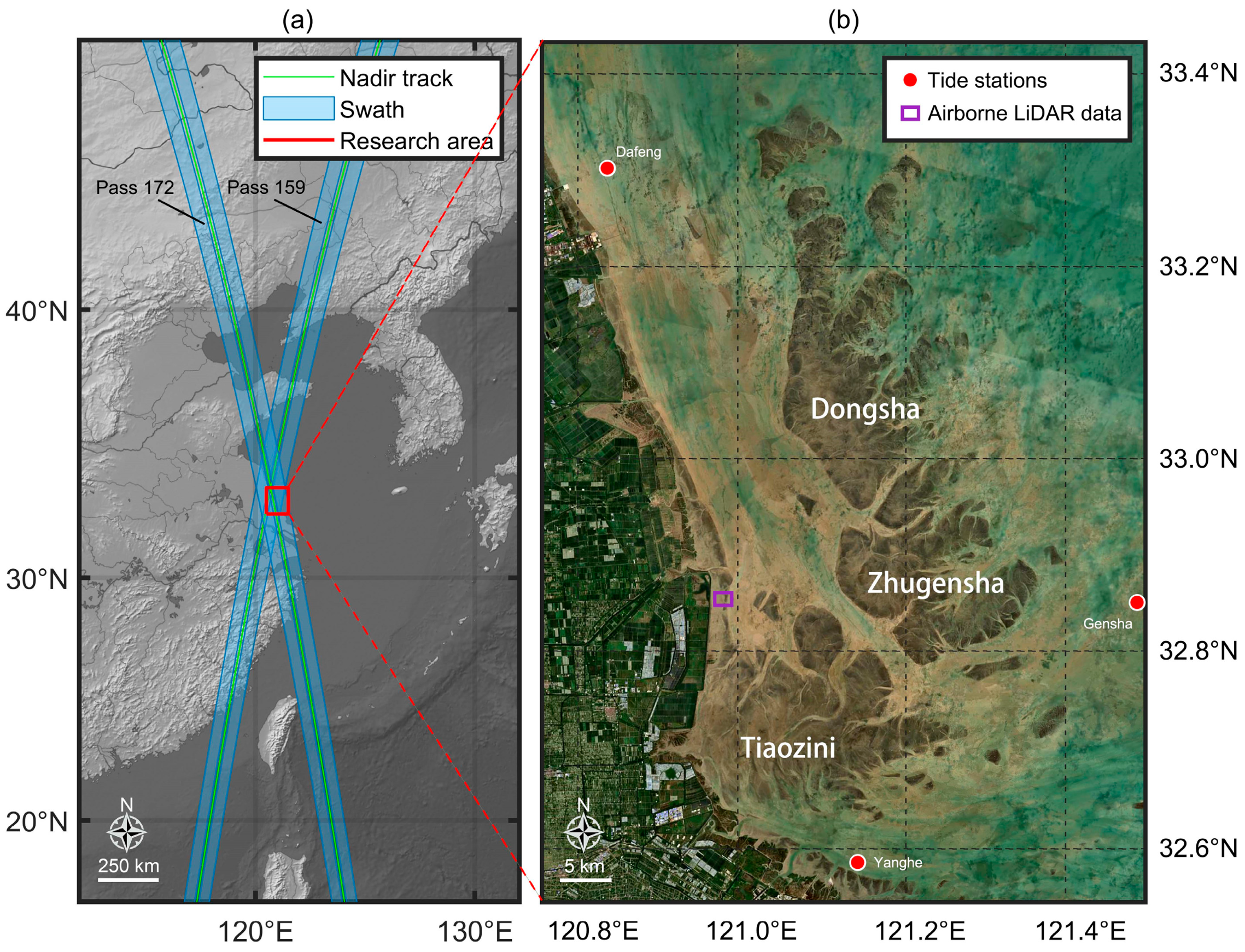
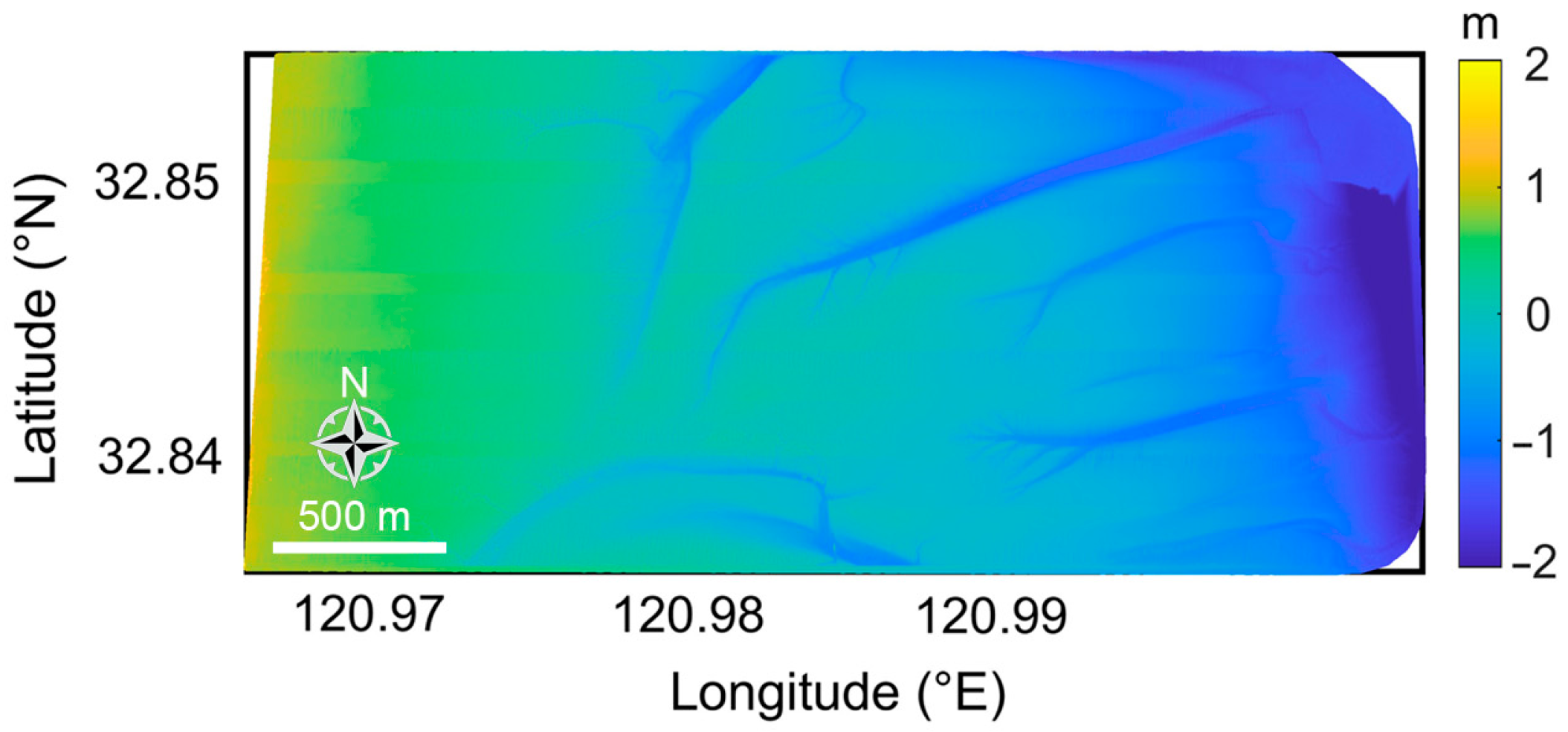
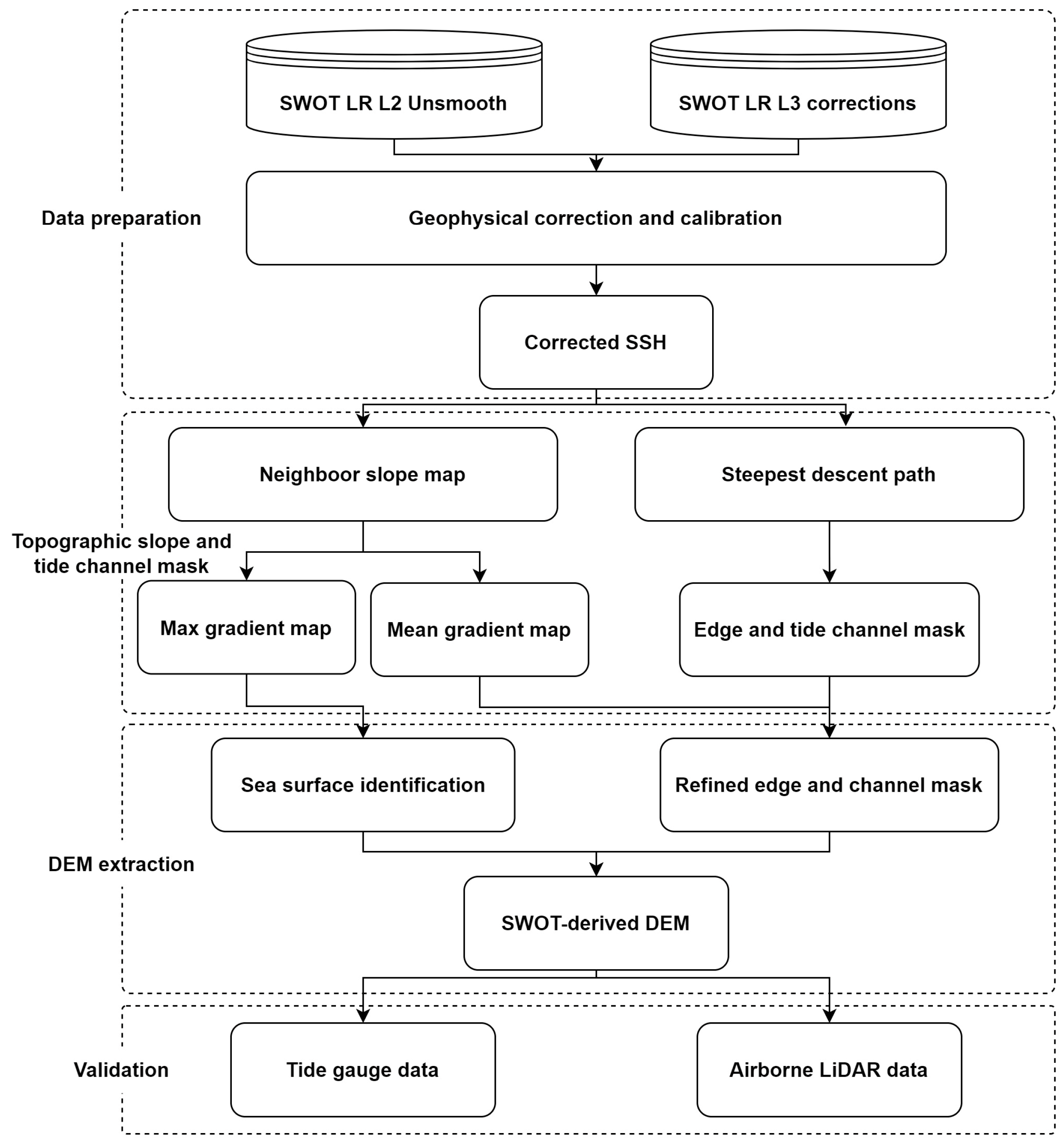

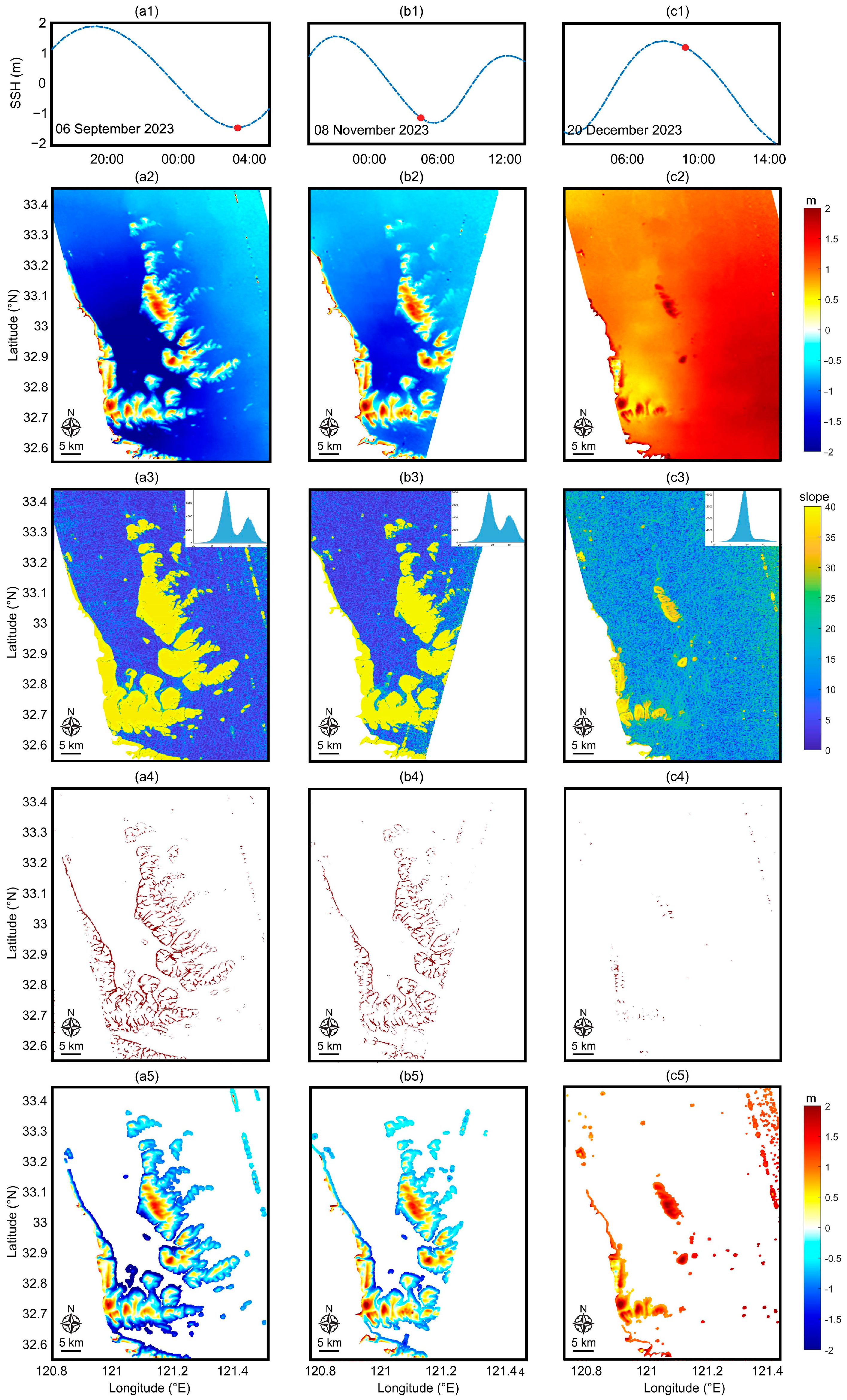


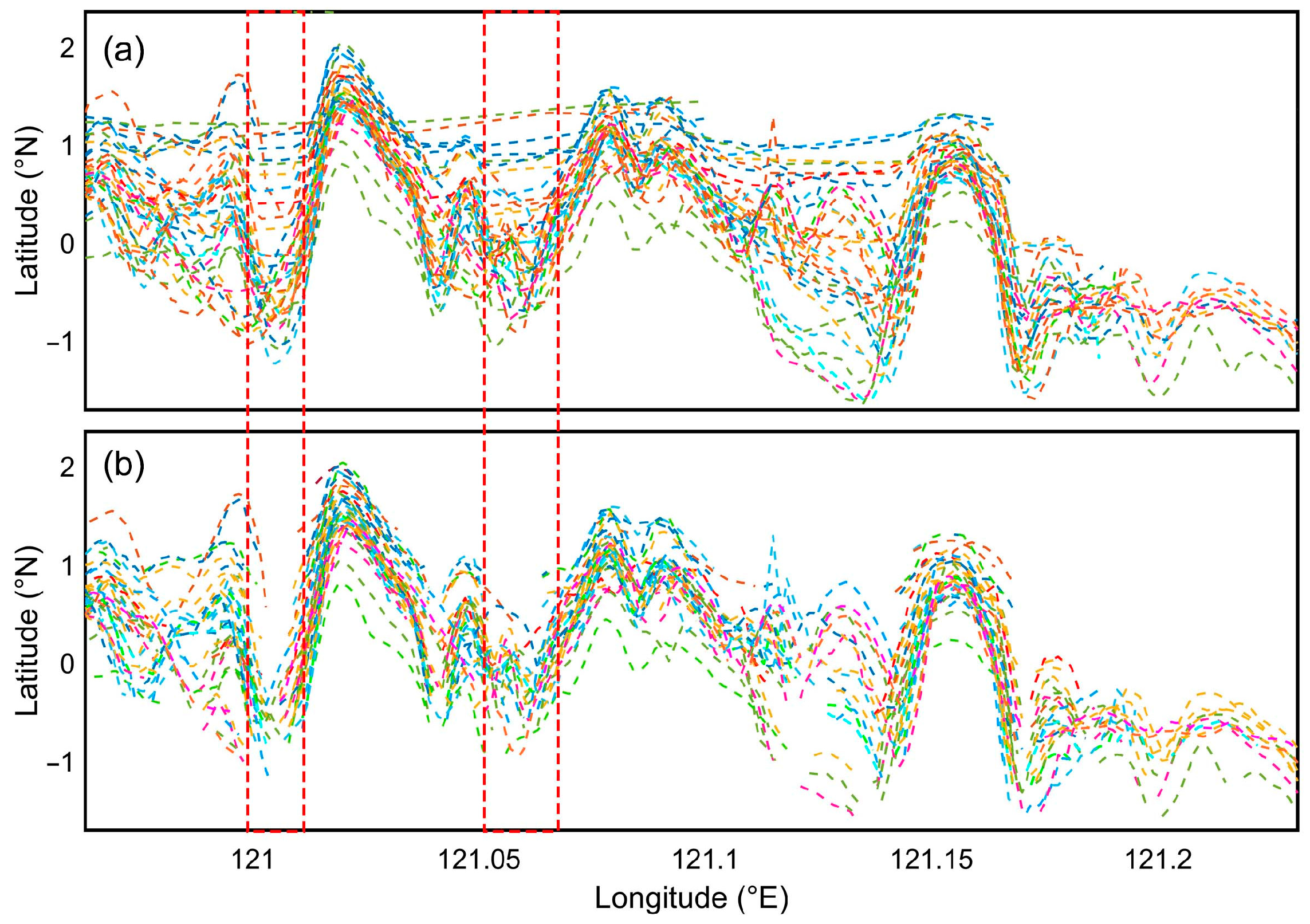
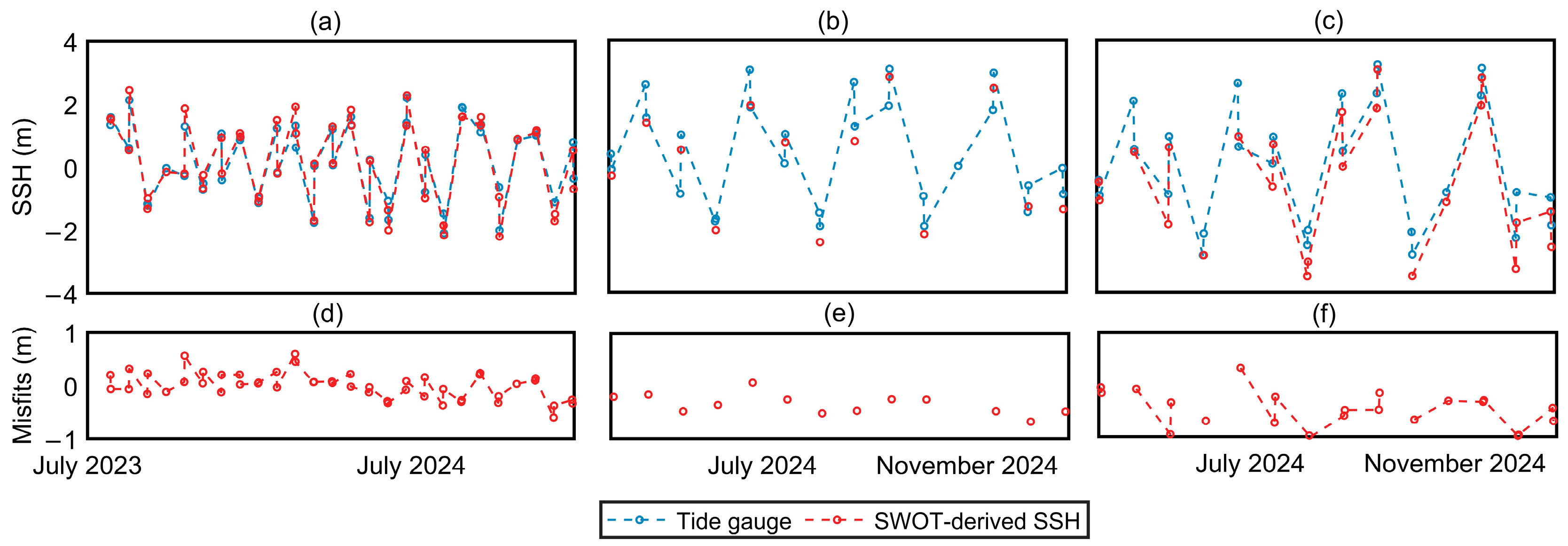

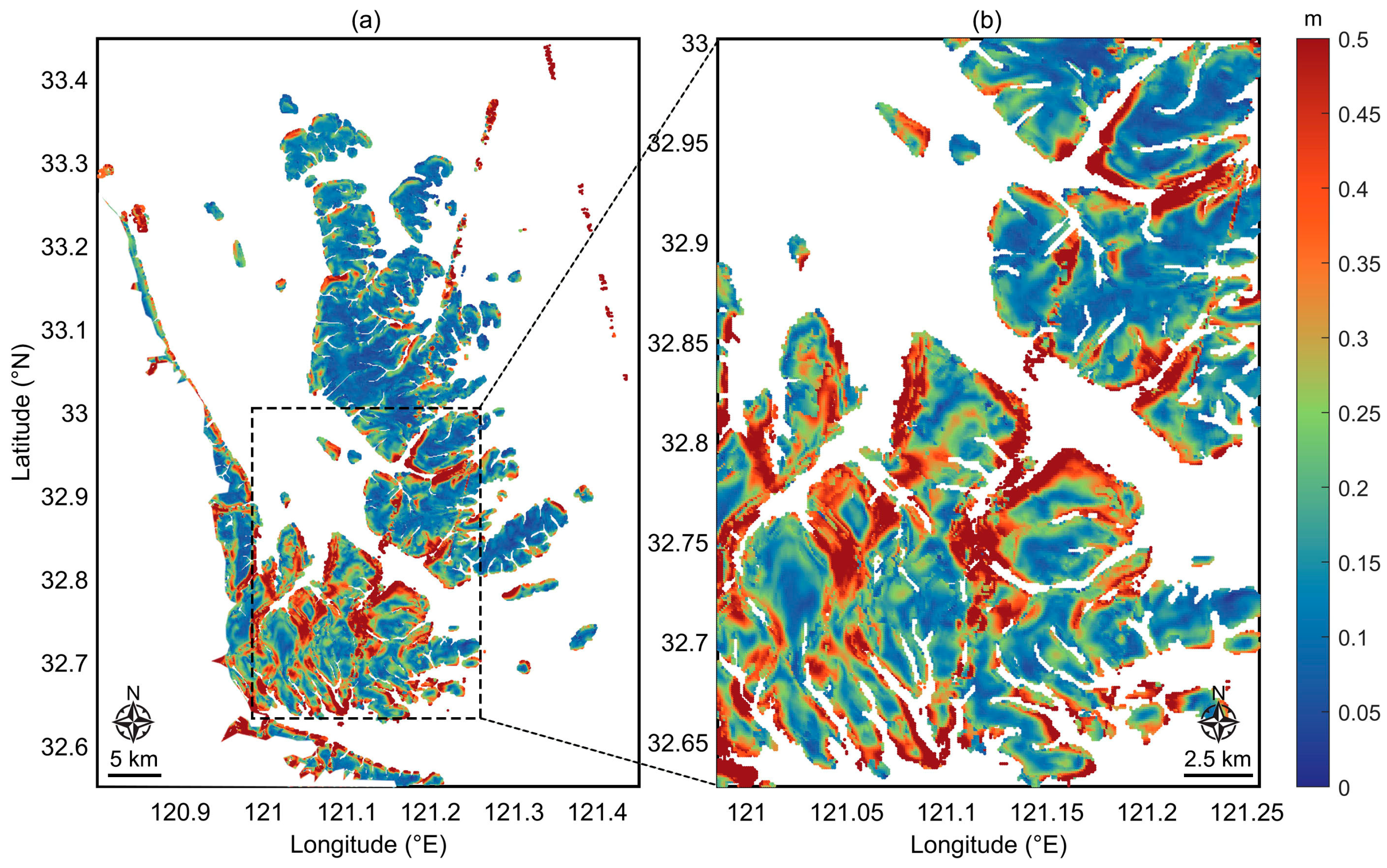

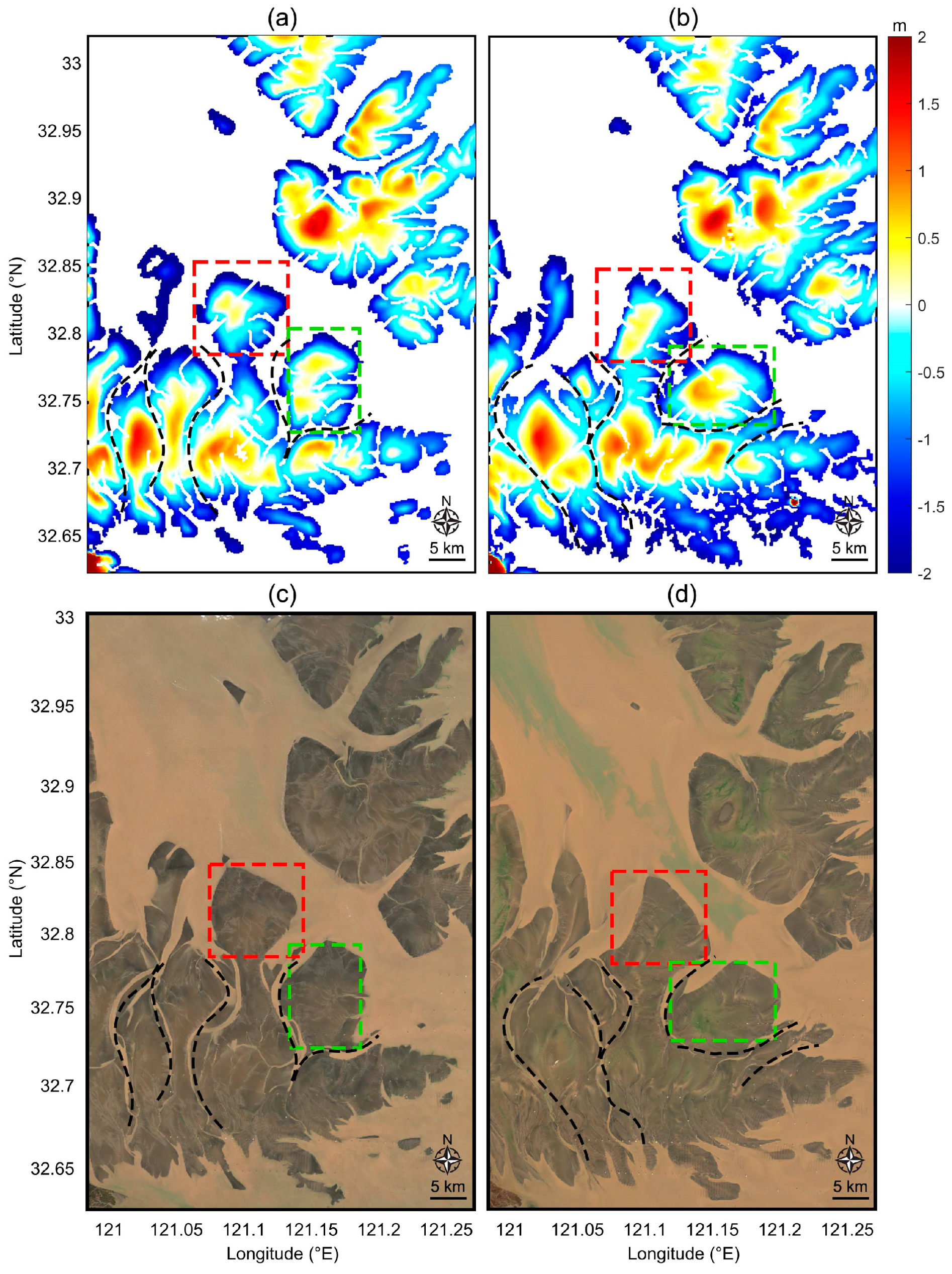
| Tide Stations | Max | Min | Mean | RMSE |
|---|---|---|---|---|
| Dafeng | 0.59 | −0.60 | 0.01 | 0.25 |
| Gensha | 0.26 | −0.47 | −0.16 | 0.19 |
| Yanghe | 0.62 | −0.70 | −0.19 | 0.32 |
Disclaimer/Publisher’s Note: The statements, opinions and data contained in all publications are solely those of the individual author(s) and contributor(s) and not of MDPI and/or the editor(s). MDPI and/or the editor(s) disclaim responsibility for any injury to people or property resulting from any ideas, methods, instructions or products referred to in the content. |
© 2025 by the authors. Licensee MDPI, Basel, Switzerland. This article is an open access article distributed under the terms and conditions of the Creative Commons Attribution (CC BY) license (https://creativecommons.org/licenses/by/4.0/).
Share and Cite
Shi, H.; Jia, D.; He, X.; Andersen, O.B.; Zheng, X. SWOT-Based Intertidal Digital Elevation Model Extraction and Spatiotemporal Variation Assessment. Remote Sens. 2025, 17, 1516. https://doi.org/10.3390/rs17091516
Shi H, Jia D, He X, Andersen OB, Zheng X. SWOT-Based Intertidal Digital Elevation Model Extraction and Spatiotemporal Variation Assessment. Remote Sensing. 2025; 17(9):1516. https://doi.org/10.3390/rs17091516
Chicago/Turabian StyleShi, Hongkai, Dongzhen Jia, Xiufeng He, Ole Baltazar Andersen, and Xiangtian Zheng. 2025. "SWOT-Based Intertidal Digital Elevation Model Extraction and Spatiotemporal Variation Assessment" Remote Sensing 17, no. 9: 1516. https://doi.org/10.3390/rs17091516
APA StyleShi, H., Jia, D., He, X., Andersen, O. B., & Zheng, X. (2025). SWOT-Based Intertidal Digital Elevation Model Extraction and Spatiotemporal Variation Assessment. Remote Sensing, 17(9), 1516. https://doi.org/10.3390/rs17091516






